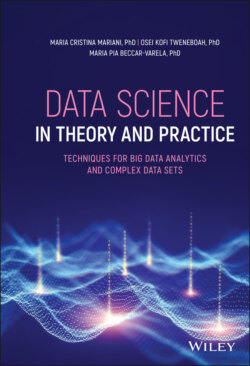Читать книгу Data Science in Theory and Practice - Maria Cristina Mariani - Страница 14
1.3 Who is a Data Scientist?
ОглавлениеThe term “data scientist” was invented as recently as 2008 when companies realized the need for data professionals who are skilled in organizing and analyzing massive amounts of data. Data scientists are quantitative and analytical data experts who utilize their skills in both technology and social science to find trends and manage the data around them. With the growth of big data integration in business, they have evolved at the forefront of the data revolution. They are part mathematicians, statisticians, computer programmers, and analysts who are equipped with a diverse and wide‐ranging skill set, balancing knowledge in several computer programming languages with advanced experience in statistical learning and data visualization.
There is not a definitive job description when it comes to a data scientist role. However, we outline here some stuffs they do:
Collecting and recording large amounts of unruly data and transforming it into a more usable format.
Solving business‐related problems using data‐driven techniques.
Working with a variety of programming languages, including SAS, Minitab, R, and Python.
Having a strong background of mathematics and statistics including statistical tests and distributions.
Staying on top of quantitative and analytical techniques such as machine learning, deep learning, and text analytics.
Communicating and collaborating with both IT and business.
Looking for order and patterns in data, as well as spotting trends that enables businesses to make informed decisions.
Some of the useful tools that every data scientist or practitioner needs are outlined below:
Data preparation: The process of cleaning and transforming raw data into suitable formats prior to processing and analysis.
Data visualization: The presentation of data in a pictorial or graphical format so it can be easily analyzed.
Statistical learning or Machine learning: A branch of artificial intelligence based on mathematical algorithms and automation. Artificial intelligence (AI) refers to the process of building smart machines capable of performing tasks that typically require human intelligence. They are designed to make decisions, often using real-time data. Real-time data are information that is passed along to the end user immediately it is gathered.
Deep learning: An area of statistical learning research that uses data to model complex abstractions.
Pattern recognition: Technology that recognizes patterns in data (often used interchangeably with machine learning).
Text analytics: The process of examining unstructured data and drawing meaning out of written communication.
We will discuss all the above tools in details in this book. There are several scientific and programming skills that every data scientist should have. They must be able to utilize key technical tools and skills, including R, Python, SAS, SQL, Tableau, and several others. Due to the ever growing technology, data scientist must always learn new and emerging techniques to stay on top of their game. We will discuss the R and Python programming in Chapters 5 and 6.
